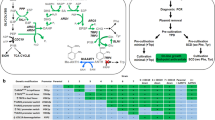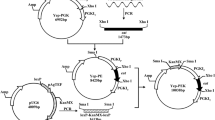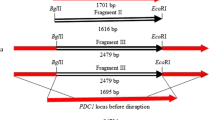Abstract
2-phenylethanol (2-PE) is an important aromatic compound with a rose-like fragrance widely used in food industry and cosmetic manufacture. In order to obtain “natural” 2-PE, the genetically modified budding yeasts were developed and applied for the 2-PE production. The gene ARO8 encoding transaminase and the gene ARO10 encoding decarboxylase in the Ehrlich pathway were expressed in Saccharomyces cerevisiae S288c. The activities of transaminase and decarboxylase were both enhanced in the corresponding recombinant strains. Consequently, the 2-PE yield in the recombinant strains with ARO8 and ARO10 were increased by 9.3 and 16.3 %, respectively, than that in the wild strain. A co-expression vector harboring ARO8 and ARO10 was then introduced into S. cerevisiae S288c, generating the recombinant strain SPO810. The fed-batch fermentation results indicated that the 2-PE yield in SPO810 reached 2.61 g L−1 after 60 h of cultivation, which was 36.8 % higher than that in the wild strain. These results demonstrated that the 2-PE production was significantly improved by enhanced expression of the two key enzymes encoded by ARO8 and ARO10 in the Ehrlich pathway, providing new perspectives for enhancing “natural” 2-PE production in S. cerevisiae.




Similar content being viewed by others
References
Amberg DC, Burke DJ, Strathern JN (2005) Methods in yeast genetics: a cold spring harbor laboratory course manual, 2005th edn. Cold Spring Harbor Laboratory Press, New York
Brammer LA, Meyers CF (2009) Revealing substrate promiscuity of 1-deoxy-d-xylulose 5-phosphate synthase. Org Lett 11:4748–4751
Carmona M, Zamarro MT, Blázquez B et al (2009) Anaerobic catabolism of aromatic compounds: a genetic and genomic view. Microbiol Mol Biol Rev 73:71–133
Eshkol N, Sendovski M, Bahalul M et al (2009) Production of 2-phenylethanol from l-phenylalanine by a stress tolerant Saccharomyces cerevisiae strain. J Appl Microbiol 106:534–542
Etschmann MMW, Bluemke W, Sell D et al (2002) Biotechnological production of 2-phenylethanol. Appl Microbiol Biotechnol 59:1–8
Guimarães PM, Teixeira JA, Domingues L (2010) Fermentation of lactose to bio-ethanol by yeasts as part of integrated solutions for the valorisation of cheese whey. Biotechnol Adv 28:375–384
Hazelwood LA, Daran JM, van Maris AJA et al (2008) The Ehrlich pathway for fusel alcohol production: a century of research on Saccharomyces cerevisiae metabolism. Appl Environ Microbiol 74:2259–2266
Hu Y, Wang XJ, Li H et al (2012) Determination of steady-state kinetic parameters of 1-deoxy-d-xylulose-5-phosphate synthase by pre-column derivatization high performance liquid chromatography using 2, 4-dinitrophenylhydrazine as derivative reagent. Chinese J Anal Chem 40:1859–1864
Hua D, Xu P (2011) Recent advances in biotechnological production of 2-phenylethanol. Biotechnol Adv 29:654–660
Iraqui I, Vissers S, Cartiaux M et al (1998) Characterization of Saccharomyces cerevisiae ARO8 and ARO9 genes encoding aromatic aminotransferases I and II reveals a new aminotransferase subfamily. Mol Gen Genet 257:238–248
Kim B, Cho BR, Hahn JS (2014) Metabolic engineering of Saccharomyces cerevisiae for the production of 2-phenylethanol via Ehrlich pathway. Biotechnol Bioeng 111:115–124
Kondo T, Tezuka H, Ishii J et al (2012) Genetic engineering to enhance the Ehrlich pathway and alter carbon flux for increased isobutanol production from glucose by Saccharomyces cerevisiae. J Biotechnol 159:32–37
Li M, Petteys BJ, McClure JM et al (2010) Thiamine biosynthesis in Saccharomyces cerevisiae is regulated by the NAD+-dependent histone deacetylase Hst1. Mol Cell Biol 30:3329–3341
Mei JF, Min H, Lu ZM (2009) Enhanced biotransformation of l-phenylalanine to 2-phenylethanol using an in situ product adsorption technique. Process Biochem 44:886–890
Perpète P, Duthoit O, De Maeyer S et al (2006) Methionine catabolism in Saccharomyces cerevisiae. FEMS Yeast Res 6:48–56
Sambrook J, Russel DW (2001) Molecular cloning: a laboratory manual, 3rd edn. Cold Spring Harbor Laboratory Press, New York
Stark D, Münch T, Sonnleitner B et al (2002) Extractive bioconversion of 2-phenylethanol from l-phenylalanine by Saccharomyces cerevisiae. Biotechnol Prog 18:514–523
Tokuhiro K, Ishida N, Nagamori E et al (2009) Double mutation of the PDC1 and ADH1 genes improves lactate production in the yeast Saccharomyces cerevisiae expressing the bovine lactate dehydrogenase gene. Appl Microbiol Biotechnol 82:883–890
Vuralhan Z, Morais MA, Tai SL et al (2003) Identification and characterization of phenylpyruvate decarboxylase genes in Saccharomyces cerevisiae. Appl Environ Microbiol 69:4534–4541
Xu P, Hua D, Ma C (2007) Microbial transformation of propenylbenzenes for natural flavor production. Trends Biotechnol 25:571–576
Zelle RM, de Hulster E, van Winden WA et al (2008) Malic acid production by Saccharomyces cerevisiae: engineering of pyruvate carboxylation, oxaloacetate reduction, and malate export. Appl Environ Microbiol 74:2766–2777
Acknowledgments
This work was supported by Beijing Municipal Natural Science Foundation (Grant No. 5122008), the National Natural Science Foundation of China (NSFC, Grant No. 31071593), and the Project of Construction of Innovative Teams and Teacher Career Development for Universities and Colleges under Beijing Municipality (Grant No. IDHT20130506).
Author information
Authors and Affiliations
Corresponding author
Rights and permissions
About this article
Cite this article
Yin, S., Zhou, H., Xiao, X. et al. Improving 2-Phenylethanol Production via Ehrlich Pathway Using Genetic Engineered Saccharomyces cerevisiae Strains. Curr Microbiol 70, 762–767 (2015). https://doi.org/10.1007/s00284-015-0785-y
Received:
Accepted:
Published:
Issue Date:
DOI: https://doi.org/10.1007/s00284-015-0785-y




